

Femininity during medieval times. Femininity during medieval times The role of the female has evolved enormously since medieval times; today it is commonplace for women to balance their work and home lives.
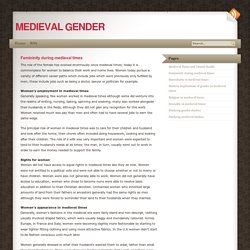
Women today pursue a variety of different career paths which include jobs which were previously only fulfilled by men; these include jobs such as being a doctor, lawyer or politician for example. Women’s employment in medieval times Generally speaking, few women worked in medieval times although some did venture into the realms of writing, nursing, baking, spinning and weaving; many also worked alongside their husbands in the fields, although they did not gain any recognition for this work.
Women received much less pay than men and often had to have several jobs to earn the same wage. History: Middle Ages. Medieval English Literature. In a Nutshell What do these things have in common?
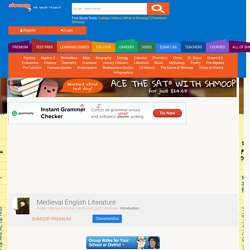
A king wielding a magical sword named ExcaliburA rude red-haired guy telling a highly-embellished fart jokeTruly righteous jousting tournaments with armored knights A woman who sees visions of Jesus and warns people to repent their sins If you guessed "Things I Saw On My Last Trip to Las Vegas," you lose.
These kings, jesters, knights, and maidens fair (and ugly) are all lifted straight from medieval literature. And you thought you might be in for a real snooze fest with this one. The phrase "Medieval English literature" refers to works that were produced in England from about the fall of Rome (the late 400s CE) to the invention of the printing press in the 15th century. For those of you who are keeping score—and we hope you are—that's about one thousand years of literature.
There is some method to the madness of these literary epochs, though. Consider, for a moment, how a lot of early medieval literature circulated orally. What's that? History for Kids - Fun Facts and Information. Medieval Times. In the Medieval times, marriage was quite different than today.
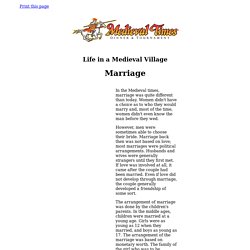
Women didn't have a choice as to who they would marry and, most of the time, women didn't even know the man before they wed. However, men were sometimes able to choose their bride. Marriage back then was not based on love; most marriages were political arrangements. Husbands and wives were generally strangers until they first met. If love was involved at all, it came after the couple had been married. The arrangement of marriage was done by the children's parents. After the marriage was arranged, a wedding notice was posted on the door of the church.
There were several reasons for prohibiting a marriage. The church ceremony in the middle ages took place outside the church door before entering for a nuptial mass. Many of the items and rituals that took place during the time of a wedding have become traditions and are practiced today. In today’s marriages, divorce is acceptable for practically any reason.
When were the Middle Ages? Medieval historians have been debating for many years on when were the Middle Ages – was there a year that medieval period began, and was there a year that it ended?
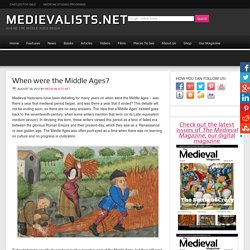
This debate will not be ending soon, so there are no easy answers. The idea that a’Middle Ages’ existed goes back to the seventeenth-century, when some writers mention that term (or its Latin equivalent medium aevum). In devising this term, these writers viewed this period as a kind of failed era between the glorious Roman Empire and their present-day, which they saw as a ‘Renaissance’ or new golden age. The Middle Ages was often portrayed as a time when there was no learning, no culture and no progress in civilization. Today historians usually do not have such a negative view of the Middle Ages, but they still want to give it a set period in history. Historical era. Alternative titles: le moyen âge; media tempora; medium aevium Middle Ages, Britannica Classic: The Medieval MindEncyclopædia Britannica, Inc.the period in European history from the collapse of Roman civilization in the 5th century ce to the period of the Renaissance (variously interpreted as beginning in the 13th, 14th, or 15th century, depending on the region of Europe and on other factors).
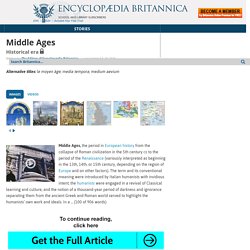
Code of Chivalry. Facts and interesting information about the life and times of the Medieval Knights of England - Code of Chivalry Code of Chivalry There was not an authentic Code of Chivalry as such.
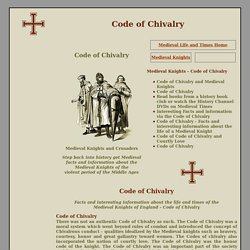
The Code of Chivalry was a moral system which went beyond rules of combat and introduced the concept of Chivalrous conduct - qualities idealized by the Medieval knights such as bravery, courtesy, honor and great gallantry toward women. The Main Characteristics of Courtly Love. Courtly Love Main characteristics: 1.
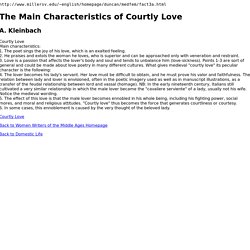
The poet sings the joy of his love, which is an exalted feeling. 2. He praises and extols the woman he loves, who is superior and can be approached only with veneration and restraint. 3. Love is a passion that affects the lover's body and soul and tends to unbalance him (love-sickness). Points 1-3 are sort of general and could be made about love poetry in many different cultures. What gives medieval "courtly love" its peculiar character is the following: 4. Courtly Love.